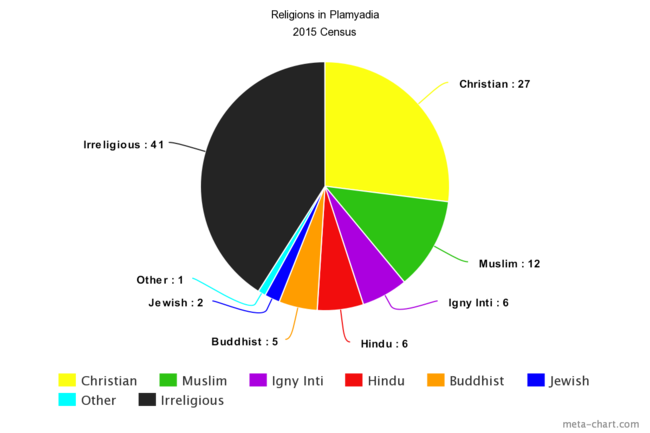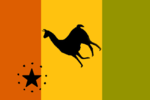Nation/Plamyadia
- Numbered list item
| This page is a work in progress by its author(s) and should not be considered final. |
| The Llamatarian Free State of Plamyadia Le Librement Lamataire État de Plamyadie (fr)
|
||||
|---|---|---|---|---|
|
||||
| Motto: Visons l'Unité, l'Égalité, la Liberté Totale | ||||
| Anthem: Ah, Ça Ira ! | ||||
| Region | Covenant | |||
| Capital and | Espace Réservé | |||
| Official languages | French, Quechua, Plamyadian Créole, Plamyadian Sign Language, Esperanto | |||
| Recognised national languages | Occitan, Basque, Tamil, Indonesian | |||
| Ethnic groups (2015) | 36% European, 24% Métis/Multiracial, 13% Amerindian, 11% South Asian, 9% Southeast Asian, 7% Other | |||
| Demonym | Plamyadian | |||
| Government | UnitaryTricameralPresidentialRepublic | |||
| - | Chef de l'État | Guilhem Robespierre Caissac | ||
| - | Senate President | Louise Rouge | ||
| - | Chair of the National Assembly | Tupac de Quiteau | ||
| - | Head Censurer | Joi Bisset | ||
| - | Supreme Justice | Mallika Kula | ||
| - | Diplomat General | Mohammad Umarputra | ||
| Legislature | La Législature | |||
| - | Upper house | Board of Censurers | ||
| - | Lower house | Senate & National Assembly | ||
| Establishment | ||||
| - | Les Îles des Lamas | 6 Vendémiaire -191 (Sep 27, 1601) | ||
| - | Plamyadian First Republic | 25 Brumaire 24 (Oct 16, 1815) | ||
| - | The Gallic Republics of South America | 26 Frimaire 30 (Dec 17, 1821) | ||
| - | Province of Cusqo | 28 Brumaire 40 (Oct 19, 1831) | ||
| - | Plamyadian Second Republic | 9 Messidor 54 (June 28, 1846) | ||
| - | Current Constitution | 3 Ventôse 130 (Feb 22, 1922) | ||
| Area | ||||
| - | 13,426 km2, 1,315 square kilometers of constructed land 5,184 sq mi |
|||
| Population | ||||
| - | 2017 estimate | 10,250,000 | ||
| - | 2015 census | 9,600,000 | ||
| - | Density | 763/km2 1,977/sq mi |
||
| GDP (PPP) | 2015 estimate | |||
| - | Total | US$841.972 billion | ||
| - | Per capita | US$87,705.42 | ||
| GDP (nominal) | 2015 estimate | |||
| - | Total | US$872.840 billion | ||
| - | Per capita | US$90,920.83 | ||
| Gini (2015) | 23.3 low |
|||
| HDI (2015) | .98 very high |
|||
| Currency | Al'pakkha (PAL) |
|||
| Time zone | Plamyadian Standard Time (PST) (UTC-5) | |||
| Does not use Daylight Saving Time. | ||||
| Antipodes | Myanma Bay of Bengal | |||
| Date format | dd-mm-yyy (An de la République AR) | |||
| Drives on the | right | |||
| Calling code | +59 | |||
| ISO 3166 code | PY | |||
| Internet TLD | .ply | |||
Plamyadia (/plɑːmˌjɑːˈdiːə/; French: Plamyadie, French pronunciation: [plɑmjɑdi]), officially The Llamatarian Free State of Plamyadia (French: Le Librement Lamataire État de Plamyadie, French pronunciation: [lə libʁəmɑ̃ lɑmɑtɛʁ eta də plɑmjɑdi]), is an island nation in the southeastern Pacific, 541 kilometers (292.1 nautical miles) off the coast of South America. The republic's largely urban population is estimated to rest around 10.25 million, 4.3 million of whom live in the sprawling capital city of Espace Réserv\. Other urban population centers can be found in Port-au-République, Volcanis, and Liurevila. Plamyadia is separated into 11 Départements, spanning a combined total of 13,426 square kilometers, including 1,315 square kilometers of artificial land in Plamyadia's territorial waters. Plamyadia controls approximately 70,000 square kilometers of water, though the main archipelago in which can be found nearly all of the republic's population is relatively compact. Plamyadia, a linguistically diverse immigrant nation, is nevertheless primarily francophone; in fact, Plamyadia was a founding member of la Francophonie. Plamyadia is a unitary presidential republic with a unique, tricameral legislature, the last remaining such legislature on Earth.
For a nation of its size, Plamyadia sees incredible climactic diversity. Though most of the archipelago is relatively temperate, experiencing warm summers and cool winters without frost, more extreme climes are not difficult to find. On the snow-capped peak of Mount Barcelora, for example, temperatures rarely rise above 10°C (50°F), while in the Llama Isles' tropical rain forests, even the winters can be unbearably hot and humid. As a result, Plamyadia is a popular tourist destination year round, seeing visitors from across the world, but particularly the American mainland. In fact, Plamyadia's largest industry is tourism, the backbone of a wealthy post-industrial state. Information technology; service industries; solar, wind, and geothermal energy; and hydroculture are also key industries.
Plamyadia is a volcanic atoll, formed from repeated eruptions of Mount Barcelora. The last such eruption was only about 600 years ago, though it was not as catastrophic as earlier, island-forming explosions. For most of its history, Plamyadia has been uninhabited by humans, instead boasting incredible paleodiversity. Recent archaeological finds, however, suggests a sustained population of Amerindian settlers in the 500 years predating the volcanoes eruption, concurrent with the die-off of many endemic species. Plamyadia's original inhabitants, however, remain enigmatic, and much of their culture and origin are a mystery.
It was not until 1581 that the islands that are today Plamyadia were again sighted by humans. Nunzio Izzo, a Sicilian explorer sailing for France, discovered the islands after being caught in a storm and blown away from the Andean coast, where he and his party had been mapping the region. Izzo named the islands after the curious beasts of burden he'd become enamored with on the mainland, llamas. Izzo would later settle on the islands, bringing with him a herd of the islands first llamas. Over the next few years, the islands would become a popular spot for homesteaders, debtors, protestants, and Republicans seeking a new life. In 1601, the islands were formally incorporated as Les Îles des Lamas, the first self-administering French territory in the west. As the French colonial empire expanded, the archipelago increasingly became the political and cultural center of Pacific France.
During the French Revolution, Plamyadia embraced the ideals of the revolutionaries, evidenced in peculiarities such as the persistence of the French Republican Calendar when it failed even in France. In 1815, while hosting exiled Emperor Napoléon Bonaparte, Plamyadia declared independence, establishing the First Plamyadian Republic. Plamyadia would later join The Gallic Republics of South America, staying with Cusqo upon the union's dissolution before again waging a war for independence. Plamyadia abstained from imperialism and kept mostly out of international politics until World War I, when a wave of pan-French fervor encouraged their involvement on the side of the Entente. Plamyadia did not strongly contribute to the war, aside from occasional naval battles with the German Pacific fleet, but, in 1918, the then-Consul, Guy Berry, used the war as an excuse to declare a state of emergency and seize the government in a military coup. A third revolution liberated the country in 1922, resulting in an entirely new constitution that persists to this day.
Plamyadia today is a cultural, technological, and economic powerhouse. Despite its small population, Plamyadia enjoys a degree of influence over the rest of the world few countries share. Plamyadia has one of the highest standards of living on Earth, and is visited by more tourists per capita than any other nation on Earth, with a total of 22 million each year, more than twice the nation's population. Additionally, Plamyadia is a center of arts, Espace Réservé being home to more art galleries and exhibitions each year than any other city. Plamyadia is also a popular destination for international students, with the highly prestigious Université de Barcelora and Université de Napoléon attracting the best of the best in nearly every field. Plamyadia is also very active on the global political stage, being a founding member of the UN, a leader in efforts to reduce carbon emissions, and a frequent source of relief aid in crises across the globe. Plamyadia is also a member of organizations such as La Francophonie, the World Trade Organization (WTO), the Council of Gallo-American Republics (CRGA), the International Union for Conservation of Nature (IUCN), and the International Energy Forum (IEF).
Contents
Etymology
It is unclear when the name Plamyadia first appeared, but the first written records of its appearance come from the mid-1700s, in the form of letters from French settlers. However, the name remains rare in historical documents up until the beginning of the 19th century, when it was adopted by rapidly growing movements for Plamyadian autonomy. It was not used officially until the establishment of the Plamyadian First Republic, in 1815.
The name's meaning and roots are also unknown, though several theories have been put forth. In the Plamyadian First Republic's declaration of independence, it was erroneously claimed that the name "Plamyadie" was derived from a Quechua word meaning freedom, perhaps to lend legitimacy to the name. Others believe it to be related to the Russian word пламя, meaning flame. Plamyadia saw a large amount of Russian immigration in the 18th century, many of whom were revolutionaries or republicans driven out of the country. Proponents of this theory believe that Plamyadia may have been associated with the metaphorical flame of revolution, and that this was adopted by local republicans and autonomists. Opponents believe it lacks substantial evidence. Other well-known theories of Plamyadia's origin include a popular misspelling or mistranslation of the word llama, and an entirely arbitrary origin, its meaning fabricated by revolutionaries.
History
Prehistory (before 1581)
The first humans to arrive in Plamyadia were Native American seafarers, likely of Andean origin, roughly 1100 years ago. Arriving in reed canoes and rafts, the earliest settlers were likely fishermen or other sailors blown off course. Regardless of origin, Plamyadia's first inhabitants found a lush and accommodating landscape, home to easy game and abundant plant life. These early sailors gone astray formed small farming villages and societies, cultivating primarily Andean crops such as potatoes, which grew and thrived for 5 centuries. Several such native sites exist across the country; some are protected by the government and open to visitors, while others are the sites of ongoing archaeological expeditions. Most famous is the Barcelora Complex, a complex of native towns and villages which were preserved in ash during Mt. Barcelora's most recent eruption, 600 years ago. Discovered in 1983, the Barcelora Complex is one of Plamyadia's most popular tourist destinations, and has often been compared to the city of Pompeii, in Italy. In 1986, shortly after excavation began, it was declared a UNESCO World Heritage Site.
Indigenous Plamyadian civilization thrived until roughly 1420 AD, when Mt. Barcelora erupted violently. While insignificant compared to some earlier eruptions, it was enough to cause the collapse of the isolated native civilization. A number of villages were drowned in ash or lava, while those who survived are believed either to have fled or put unsustainable strain on the fragile local ecosystem. Already responsible for the extinction of many indigenous organisms, the added stress of the volcanic eruption helped to permanently damage the Plamyadian biosphere, and put an end to human habitation until the age of European colonization.
Colonial era (1581-1789)
Revolutionary South America (1789-1850)
Picard and pan-Gallo-Americanism
Isolationism and the 19th century (1850-1922)
The Second Directory
Contemporary period (1922-present)
Politics
Government
Tricameral legislature
Law
Foreign relations
Military
Government finance
National symbols
Geography
Climate
Environment
Ecology
Flora
Fauna
Geography, topography, and hydrography
Administrative divisions
Economy
Infrastructure
Transport
Telecommunications
Water supply and sanitation
Agriculture
Tourism
Energy
Science and technology
Demographics
Ethnic groups
Major cities
Languages
Religion
Immigration
Health
Education
Higher Education
Culture
Art
Literature
Cinema
Music and dance
Media
Cuisine
Fashion
Sports
Architecture
Folklore
Society
Philosophy
Cultural heritage
See also
Footnotes
References
External links
| ||||||||||||||||||||||||||||



